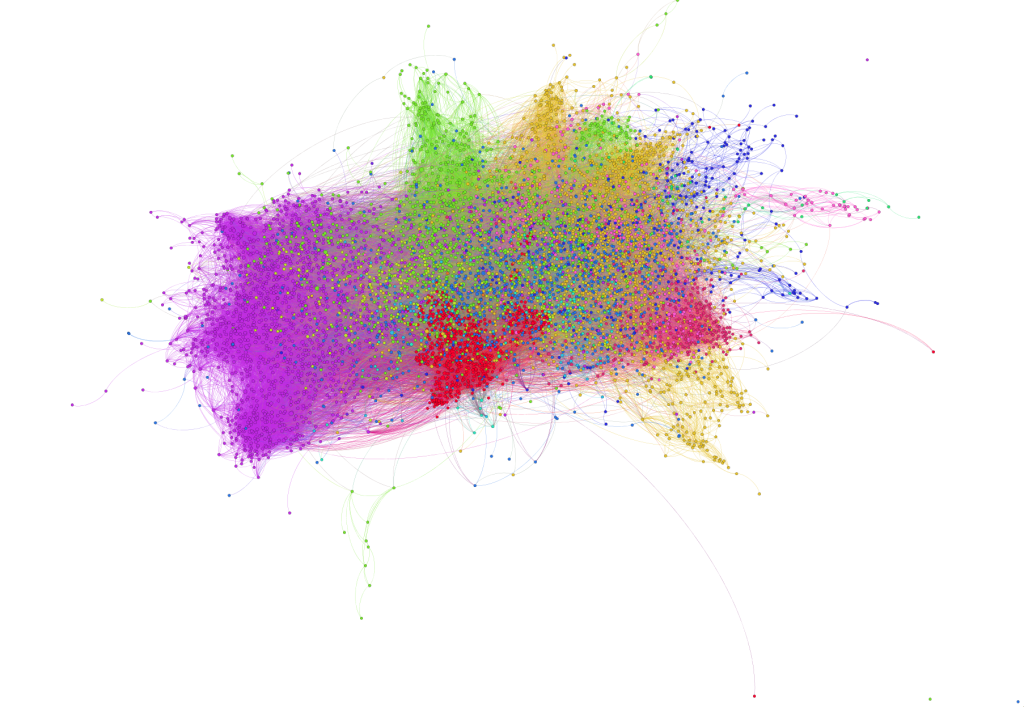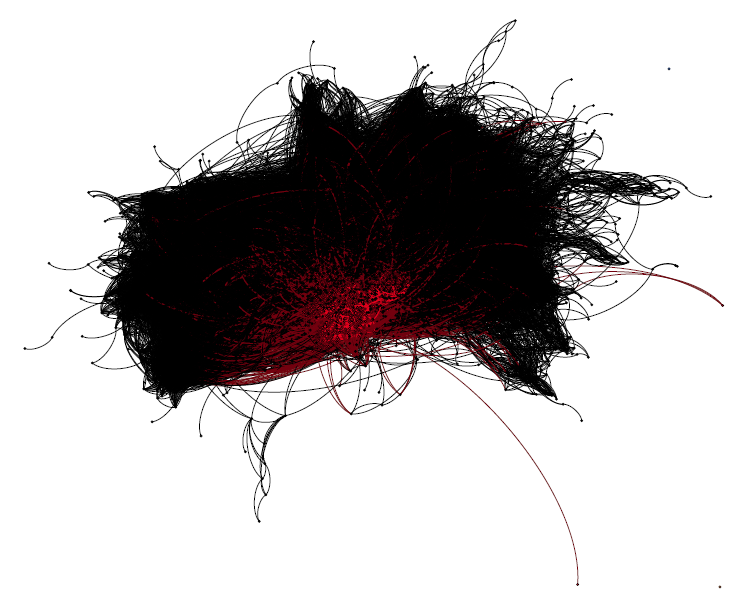If you’ve been perusing this site you may have come across some of the network maps we made to help visually demonstrate relationships between cases. They sure are pretty (thanks!), but what do they mean? This tour will take you through how the maps were made and what they mean.
Network Maps, How do they Work?
The network maps you see on this site were created by combining two data sets: the Supreme Court Database, and the Citation Network. The Supreme Court Database (created by these institutions) has all of the supreme court cases from 1945-2012 in it with lots of supporting data about their history and resolution. The Citation Network is a collection of all the citations that were used in Supreme Court decisions from 1754-2002. We combined these two datasets in a network map visualization program called Gephi, to create this map below (use the controls at the bottom right to zoom):

View as an SVG
In this map each case is a colored dot or node (colored by the issue in the case) and they are connected by lines or edges, which represent a citation. First Amendment cases are in red. Gephi links the cases by citations and then runs an algorithm on them to place cases that cite similar cases closer together and those that cite different cases further apart. The cases with more citations exert more of a gravitational force (so to speak) on other cases, which creates the layout you see above. The cases are colored by their Issue Area as coded by the Supreme Court Database.
Below, the First Amendment cases coded (by the Supreme Court Database) are highlighted in a more stark manner:
Next we broke the First Amendment cases down into smaller issues, and gave them sizes that correlate to the number of citations the cases have received.
Sizing is important because it shows us which cases might have importance (at least in terms of citations), or had importance at one point in the court’s history.
The cases below are color-coded into four large categories: obscenity and libel (red), freedom of religion (yellow), protest and political speech (green), and government security and loyalty (purple).
As you’ll notice, there is another color group, blue, which is coded as First Amendment miscellaneous. Not very descriptive, right? So we took those out, until we get the funding to look into them in greater detail, and are left with this graph:
Dive, Dive, Dive
Let’s delve even deeper and look at the cases in a more granular fashion. As the above graph shows visually, and we have highlighted with color, the cases have formed four main grouping areas because of citation similarities (with one outlier set, conscientious objectors). The size of the cases, as said before, is based on citations received, which gives us a general idea of the importance of a case. Read about how the issues were coded here.
Obscenity and libel
These are the smaller areas (and their colors):
commercial speech, excluding attorneys*
libel, defamation: defamation of public officials and public and private persons
libel, privacy: true and false light invasions of privacy
obscenity, state (cf. comity: privacy): including the regulation of sexually explicit material under the 21st Amendment
obscenity, federal
Click on some of the larger cases, like Roth v. US and New York Times Co. v. Sullivan, to reveal more information about them. What cases are they linked to? Does the position of Roth (close to most of the other cases) and of New York Times (further away) tell you anything about how they might be related to other obscenity and libel cases?
*We chose to include Commercial Speech because it’s cases were closely related to the obscenity and libel ones, though they are not exactly the same.
Freedom of Religion
These cases focus on freedom of religion. The cases are colored by their Issue Area as coded by the Supreme Court Database.
free exercise of religion
parochiaid: government aid to religious schools, or religious requirements in public schools
establishment of religion (other than as pertains to parochiaid:)
Protest and Political Speech
These cases focus on the right to protest and political speech. The cases are colored by their Issue Area as coded by the Supreme Court Database.
protest demonstrations (other than as pertains to sit-in demonstrations): demonstrations and other forms of protest based on First Amendment guarantees
conscientious objectors (cf. military draftee or military active duty) to military service
campaign spending (cf. governmental corruption):
Loyalty and Government Security
These cases focus on attempts to regulate speech on the grounds of government security. The cases are colored by their Issue Area as coded by the Supreme Court Database.
legislative investigations: concerning internal security only
federal internal security legislation: Smith, Internal Security, and related federal statutes
loyalty oath or non-Communist affidavit (other than bar applicants, government employees, political party, or teacher)
loyalty oath: bar applicants (cf. admission to bar, state or federal or U.S. Supreme Court)
loyalty oath: government employees
loyalty oath: political party
loyalty oath: teachers
security risks: denial of benefits or dismissal of employees for reasons other than failure to meet loyalty oath requirements
